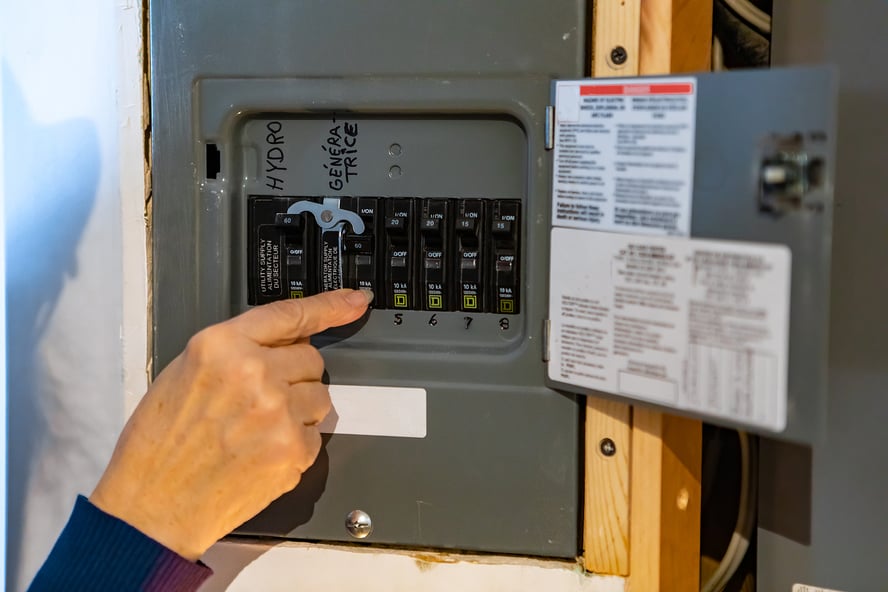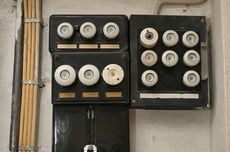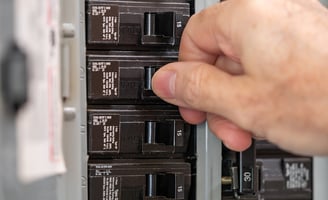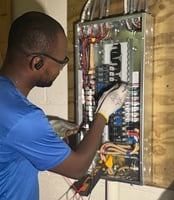Your electrical service panel is the brain of your home’s electrical system. It is the dedicated...
Electrical Service Panel Basics for Homeowners
 New homeowners often start from scratch in learning how their homes work. Electrical service panel basics can be an excellent place to start. After this "anatomy" lesson and primer on a service panel, you'll be more knowledgeable as a homeowner.
New homeowners often start from scratch in learning how their homes work. Electrical service panel basics can be an excellent place to start. After this "anatomy" lesson and primer on a service panel, you'll be more knowledgeable as a homeowner.
How The Control Panel Works
The control panel is the brain center of your electrical system. The control panel could look intimidating if you grew up in a house with a fuse box. However, they are easy to use as flipping switches. Let's explain.
When you look at the front of the control panel, you will see rows of switches. These switches, called breakers, are generally black and rectangular. Most home control panels have two rows of breakers with several breakers on each side.
Breakers have replaced fuses as the center or hub of the electrical connections coming into the house and sending power out through wires and along paths called circuits.
The Difference Between Fuses and Breakers
 Fuse boxes of old received and disseminated electrical power throughout the house. They did their job in a time when electrical usage was far less demanding than it is today. Fuses look like giant, stubby screws with a glass window on the top. They generally come in several colors: blue, yellow, and red. Each color corresponds to the amperage (size) of the fuse. If there were a power surge, the fuse would "blow," and the connection inside would be broken, cutting off the flow of electrical current to the outlet or fixture. The fix was usually to replace the fuse, thereby reconnecting the flow of electricity. Replacing the fuse with one of the same size (amperage) was critical. If it were too small, it would blow out immediately; if it were too large, it could cause bigger problems, like a potential fire. In addition, it could be difficult to detect the blown fuse, as the filament inside is tiny.
Fuse boxes of old received and disseminated electrical power throughout the house. They did their job in a time when electrical usage was far less demanding than it is today. Fuses look like giant, stubby screws with a glass window on the top. They generally come in several colors: blue, yellow, and red. Each color corresponds to the amperage (size) of the fuse. If there were a power surge, the fuse would "blow," and the connection inside would be broken, cutting off the flow of electrical current to the outlet or fixture. The fix was usually to replace the fuse, thereby reconnecting the flow of electricity. Replacing the fuse with one of the same size (amperage) was critical. If it were too small, it would blow out immediately; if it were too large, it could cause bigger problems, like a potential fire. In addition, it could be difficult to detect the blown fuse, as the filament inside is tiny.
When a power surge occurs with a control panel and breakers, the breaker, or switch, for that connection will click over, breaking the line of power. If, for instance, the lights go out in one or more rooms, go to your service panel and look for the breaker(s) that are facing the opposite direction. If your electrician labeled each switch (a good electrician will do that at the time of installation or upgrade), the one facing the wrong way should match up with the area of the house that just lost power. Flip the switch back to restore the power, and all should be well. However, if the breaker immediately flips again, you may need an upgrade to add more circuits to the control panel. As a stop-gap measure, you may need to move some lamps or appliances to outlets on different circuits, lessening the power demand on the one that switched off.
How to Know if Your Control Panel is Sized Right for Your Home and Family
Depending on the electrical system's age and power, your control panel may not be the right size for your home and family.
The DC area has an abundance of beautiful, old homes that still have original or outdated wiring and need to be brought up to code. Even if your home is much newer but still pre-owned, the electrical system may not be what you need. As an example, if the previous owners were in their golden years, and your family includes three teenagers and a work-from-home parent, you will likely need an upgrade, known as a heavy-up.
A heavy-up replaces your control panel with a bigger one - more circuits and breakers - so you can safely use all the tech and digital devices you want without fear of an electrical problem.
Wilcox Electric has served Washington, DC-area homeowners for over 30 years with a reputation for quality work and reliability. Our professional team can provide a heavy-up or any other electrical need you have. Contact us, and we’ll work to earn your trust, too.



